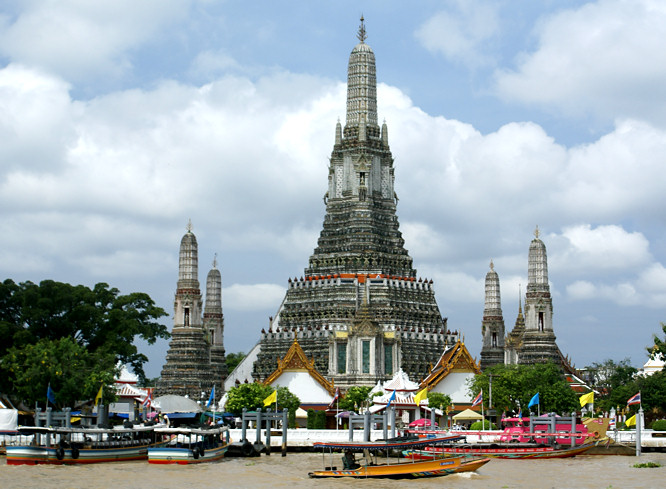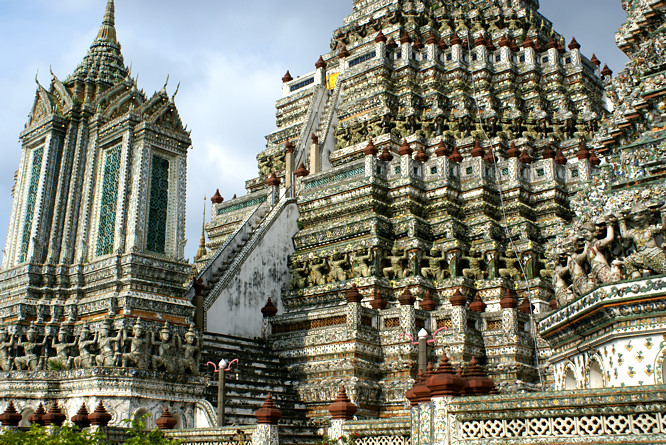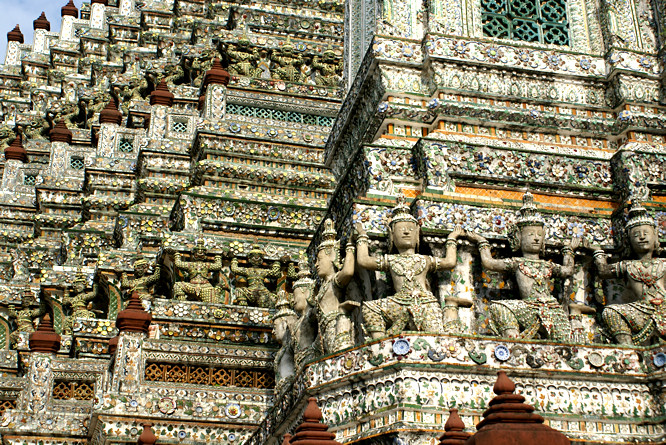Bangkok Wat Arun Temple of the Dawn
I enjoyed my trip to Bangkok's Wat Arun Temple of the Dawn on the banks of the river Chao Phraya. It is much older than other Bangkok temples. It's design and construction is very different and forms a contrast to the more modern gaudy bright colourful temples of the Royal Thai Grand Palace complex on the other side of the river.

The temple is named after the Indian God of Dawn called Aruna. The word Wat means temple or or more correctly refers to a group of religious buildings generally enclosed by a wall with several gateways.
The Wat Arun temple consists of a huge 341 foot high (104m) elongated tower known as a 'prang' and is surrounded by four smaller prangs. The architectural style of Wat Arun temple of Dawn is a blend of Khmer and Thai styles. Over the brick core, a layer of plaster was applied. Broken pieces of coloured glazed porcelain has been used to decorate the outside of the temple.
This is one of the earliest examples of recycling. These pieces of porcelain were previously used as ballast in the bottom of commercial trading vessels coming from China. Around the base of the prangs towers are various figures of ancient Chinese soldiers and animals. Over the second terrace are four statues of the Hindu God Indra riding Erawan a multi headed elephant.

I found that the decoration on the side of the Wat Arun temple looks much better from a distance than close up. It is one of the few Thai Buddhist temples that have grand steps up the main prang tower. Visitors are allowed to climb part of the way up the very steep steeps and are rewarded with a pleasant elevated view of the temple grounds and the Grand palace on the other side of the river.
Wat Arun is open between 8.30am and 5.30pm. A small entrance fee is charged but they are grateful if they receive a bigger donations. Due to it's location, the best way to get to Wat Arun is on the river. The Tha Tien express boat pier, at the southwest corner of the Grand Palace / Wat Phra Kaew, is opposite Wat Arun and ferry boats leave every few minutes.
You can get to Tha Tien by using the Chao Phraya River Express boats from any other pier as they all stop there. The best time to photograph the Wat Arun Temple is in the evening with the sun setting behind it between 6-7pm when the spires make an attractive silhouette against the skyline.
The older Buddhist temples like Wat Arun and the religious bell shaped cremation ash storage structures called Chedi are built in the shape of the mythical Buddhist mountain called Meru that is supposed to exist somewhere beyond the physical plane of reality in the realm of perfection and transcendence. The Buddhist equivalent to heaven.

A Buddhist temple was built on this location to service the religious needs of the many sailors and merchants that lived and worked in the area. It is at this point where the smaller Thonburi river meets the larger Bangkok Chao Phraya river. A little harbour developed in this region of Bangkok. Goods would be unloaded and loaded whilst the crew obtained supplies for the next voyage.
After the destruction of the ancient Siam (Thai) capital city Ayutthaya by the Burma army followed by the defeat of the Burmese army, the new King Taksin established a new capital at Thonburi on the west bank of the Chao Phraya River in what is now Bangkok. Wat Arun became a royal temple and for a brief period was host to the celebrated Emerald Buddha, before it was moved to the more modern temple Wat Phra Kaew, Temple of the Emerald Buddha, in the Grand Palace.
Folk lore has it that the first placed King Taksin went to when he arrived in what is now Bangkok was the Wat Arun temple. He arrived in the first light of Dawn and this is how it got its name. Others say it is because the high tower catches the first rays of sunshine in the morning. Wat Arun Temple of the Dawn is an outstanding ancient monument that is worth a visit.
Travel books

